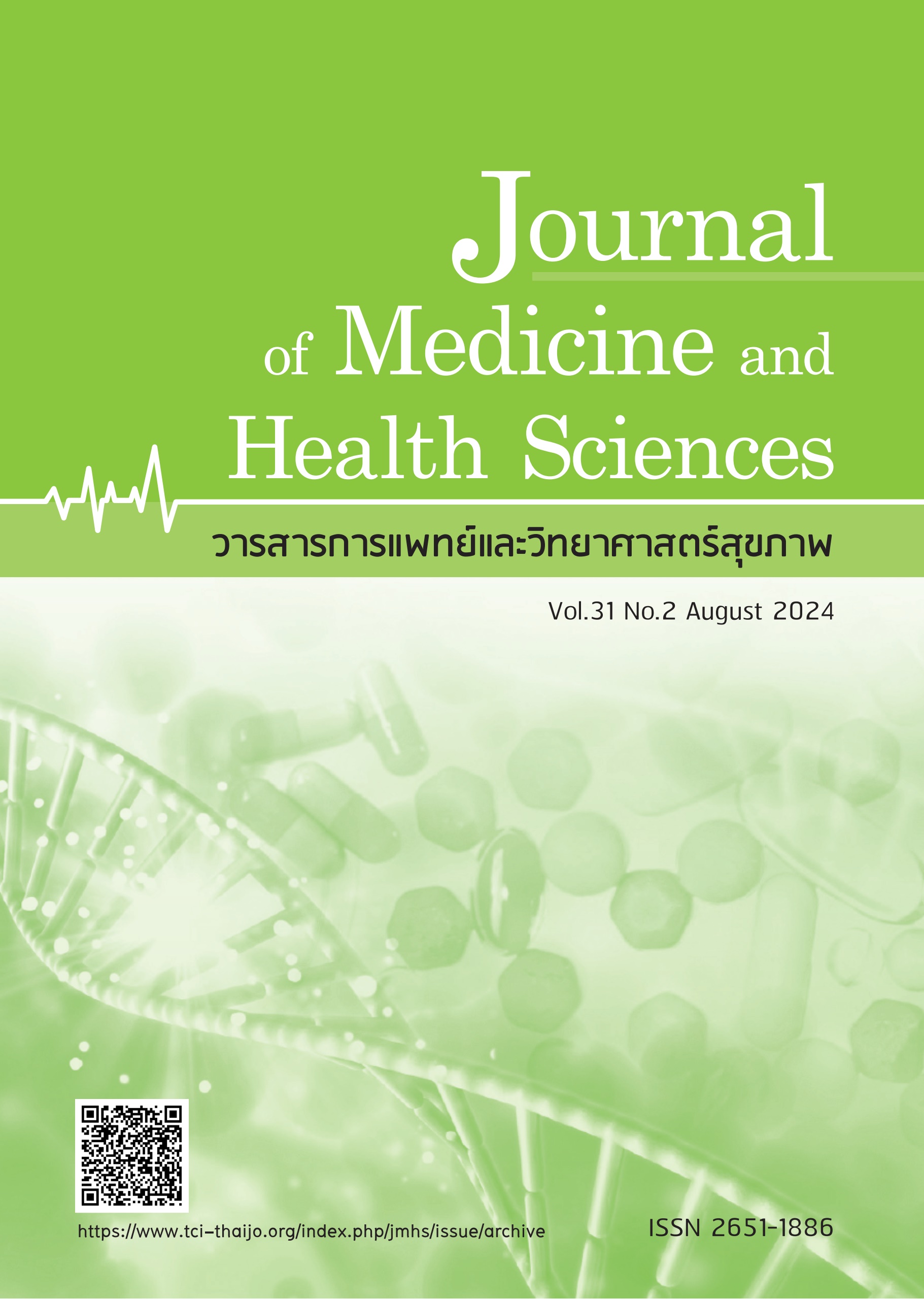Risk factors for atrial fibrillation in elderly patients with severe atherosclerotic cardiovascular disease
Keywords:
Atrial fibrillation, Elderly, Prevalence, Dangerously high ASCVD riskAbstract
Atrial fibrillation (AF) is common cardiac arrhythmia with a prevalence of approximately 0.5 to 15% and increased with the aging population. However, there have been limited studies about risk factors of AF in elderly patients with dangerously high atherosclerotic cardiovascular disease (ASCVD) risk in Thailand. This study aimed to determine prevalence and risk factors of AF in elderly patients with dangerously high ASCVD risk. This was a single-center cross-sectional study enrolled 720 patients with dangerously high ASCVD risk (Thai CVD risk > 40%) aged at least 60 years old at Kantharalak district, Sisaket province. Data was collected from Health Data Center 43 files (HDC) database (Tenth regional health center information system) including 12-leads electrocardiography (ECG) and demographic data during 31st August to 30th November 2023. The primary outcomes were prevalence and risk factors of AF. The results revealed that there were 720 patients were enrolled. Of 720 patients, 47 patients (6.5%) had AF. An average age was 79.6±7.7 years. A multivariate logistic regression model showed that AF was associated with a history of heart failure (adjusted odds ratio [aOR] 16.2, 95% Confidence interval [CI] 4.6-57.2, p<0.001), a history of valvular heart disease (adjusted odds ratio [aOR] 72.8, 95% CI 5.8-91.2, p<0.001) and beta-blockers use (aOR 6.6, 95%CI 2.9-14.8, p<0.001) in elderly patients with dangerously high ASCVD risk. In conclusion, prevalence of AF in elderly patients with dangerously high ASCVD risk were 6.5%. Risk factors associated with AF were a history of heart failure, valvular heart disease and beta-blockers use. Elderly patients with dangerously high ASCVD risk and these risk factors should be performed AF screening.
References
Stewart S, Hart CL, Hole DJ, McMurray JJ. Population prevalence, incidence, and predictors of atrial fibrillation in the Renfrew/Paisley study. Heart 2001;86(5):516-21.
Hsu J, Go AS, Selby J. Factors affecting patients' self-referral to specialists. JAMA. 2001;286:672–3.
Go AS, Hylek EM, Phillips KA, et al. Prevalence of diagnosed atrial fibrillation in adults: national implications for rhythm management and stroke prevention: the AnTicoagulation and Risk Factors in Atrial Fibrillation (ATRIA) Study. JAMA. 2001;285:2370–5.
Hobbs FD, Fitzmaurice DA, Mant J, Murray E, Jowett S, Bryan S, et al. A randomised controlled trial and cost-effectiveness study of systematic screening (targeted and total population screening) versus routine practice for the detection of atrial fibrillation in people aged 65 and over. The SAFE study. Health Technol Assess 2005;9(40):iii-iv, ix-x, 1-74.
Jeong JH. Prevalence of and risk factors for atrial fibrillation in Korean adults older than 40 years. J Korean Med Sci 2005;20(1):26-30.
Iguchi Y, Kimura K, Shibazaki K, Aoki J, Kobayashi K, Sakai K, et al. Annual incidence of atrial fibrillation and related factors inadults. Am J Cardiol 2010;106(8):1129-33.
Phrommintikul A, Detnuntarat P, Prasertwitayakij N, Wongcharoen W. Prevalence of atrial fibrillation in Thai elderly. J Geriatr Cardiol 2016;13(3):270-3.
Assantachai P, Panchavinnin P, Pisalsarakij D. An electrocardiographic survey of elderly Thai people in the rural community. J Med Assoc Thai 2002;85(12):1273-9.
Krittayaphong R, Rangsin R, Thinkhamrop B, Hurst C, Rattanamongkolgul S, Sripaiboonkij N, et al. Prevalence and associating factors of atrial fibrillation in patients with hypertension: a nation-wide study. BMC Cardiovasc Disord 2016;16:1-7.
Atrial Fibrillation Investigators. Risk factors for stroke and efficacy of antithrombotic therapy in atrial fibrillation.Analysis of pooled data from five randomized controlled trials.Arch Intern Med 1994;154(13):1449-57.
Joglar JA, Chung MK, Armbruster AL, Benjamin EJ, Chyou JY, Cronin EM, et al. 2023 ACC/AHA/ACCP/HRS guideline for the diagnosis and management of atrial fibrillation: a report of the American College of Cardiology/American Heart Association Joint Committee on Clinical Practice Guidelines. Circulation 2024;149(1):e1-56.
Huxley, RR, Filion, KB, Konety, Alonso, A. Meta-analysis of cohort and case-control studies of type 2 diabetes mellitus and risk of atrial fibrillation. Am J Cardiol. 2011;108:56–62.
Huxley, RR, Misialek, JR, Agarwal, SK, Loehr, LR, Soliman, EZ, Chen, LY, Alonso, A. Physical activity, obesity, weight change, and risk of atrial fibrillation: the Atherosclerosis Risk in Communities study. Circ Arrhythm Electrophysiol. 2014;7:620–5.
Benjamin, EJ, Levy, D, Vaziri, SM, D’Agostino, RB, Belanger, AJ, Wolf, PA. Independent risk factors for atrial fibrillation in a population-based cohort: the Framingham Heart Study. JAMA. 1994;271:840–4.
Lindberg T, Wimo A, Elmståhl S, Qiu C, Bohman DM, Sanmartin Berglund J. Prevalence and incidence of atrial fibrillation and other arrhythmias in the general older population: findings from the Swedish National Study on aging and care. Gerontology and geriatric medicine. 2019 Jun;5:2333721419859687.
Division of Non-communicable Disease. Assessment of an Atherosclerotic Cardiovascular Disease risk in diabetic and hypertensive patients. Nonthaburi: The Agricultural co-operative federation of Thailand press; 2015
Kirchhof, P., et al., 2016 ESC Guidelines for the management of atrial fibrillation developed in collaboration with EACTS. Eur Heart J, 2016. 37(38): p.2893-962.
Pisters R, Lane DA, Nieuwlaat R, De Vos CB, Crijns HJ, Lip GY. A novel user-friendly score (HAS-BLED) to assess 1-year risk of major bleeding in patients with atrial fibrillation: the Euro Heart Survey. Chest. 2010 Nov 1;138(5):1093-100.
Downloads
Published
How to Cite
Issue
Section
License
Copyright (c) 2024 Journal of Medicine and Health Sciences

This work is licensed under a Creative Commons Attribution-NonCommercial-NoDerivatives 4.0 International License.



